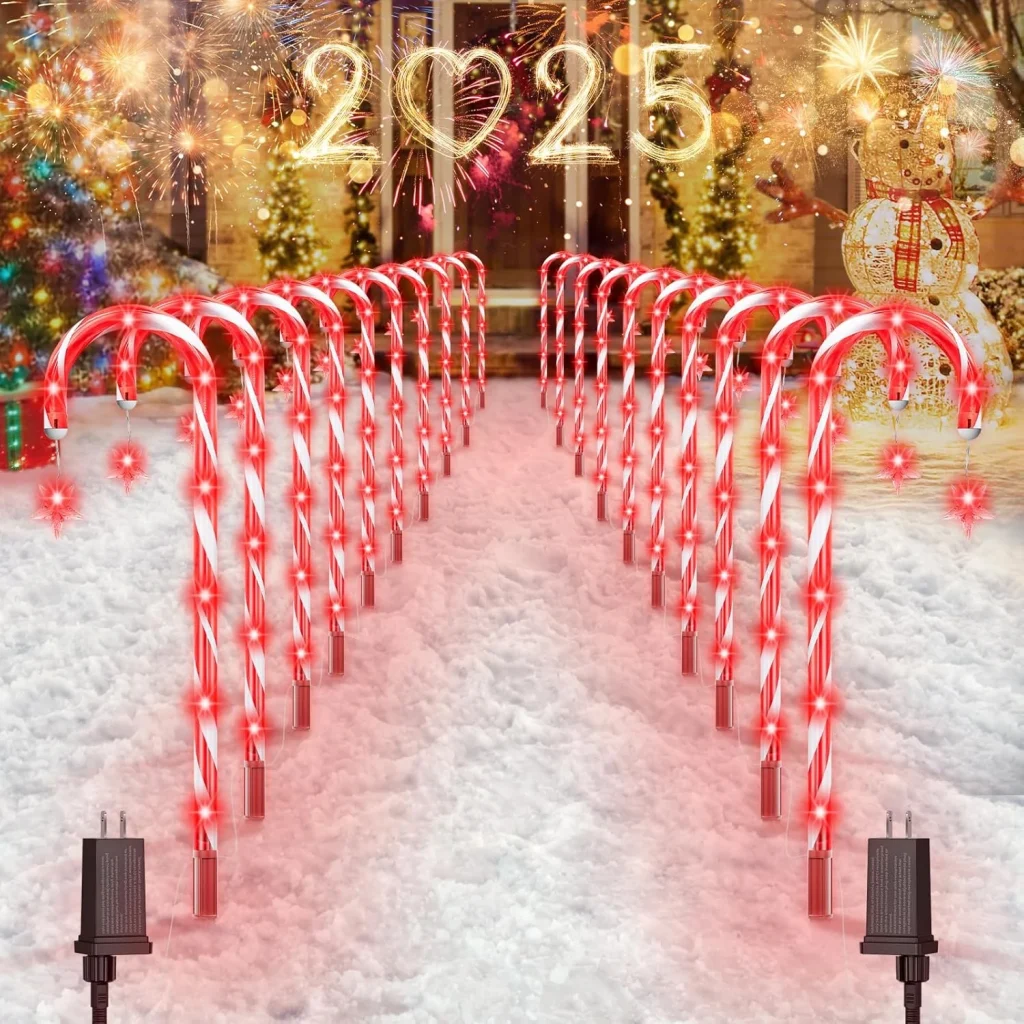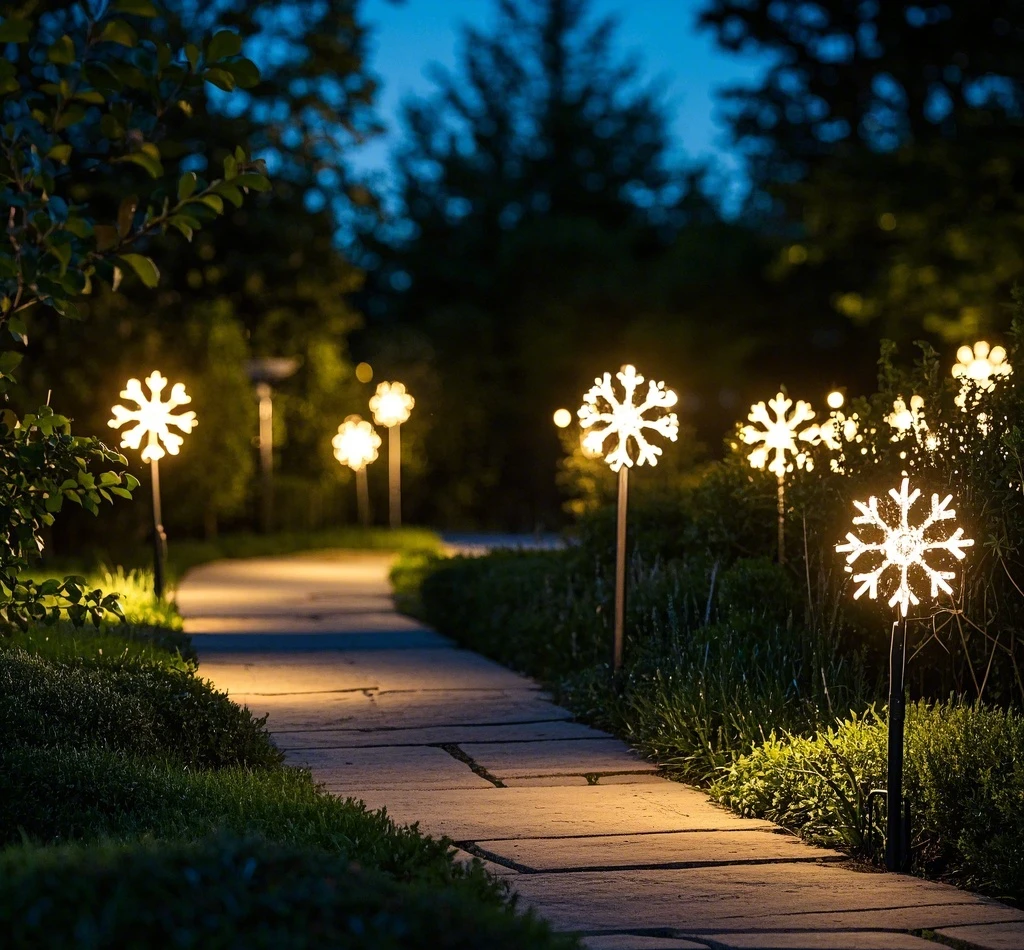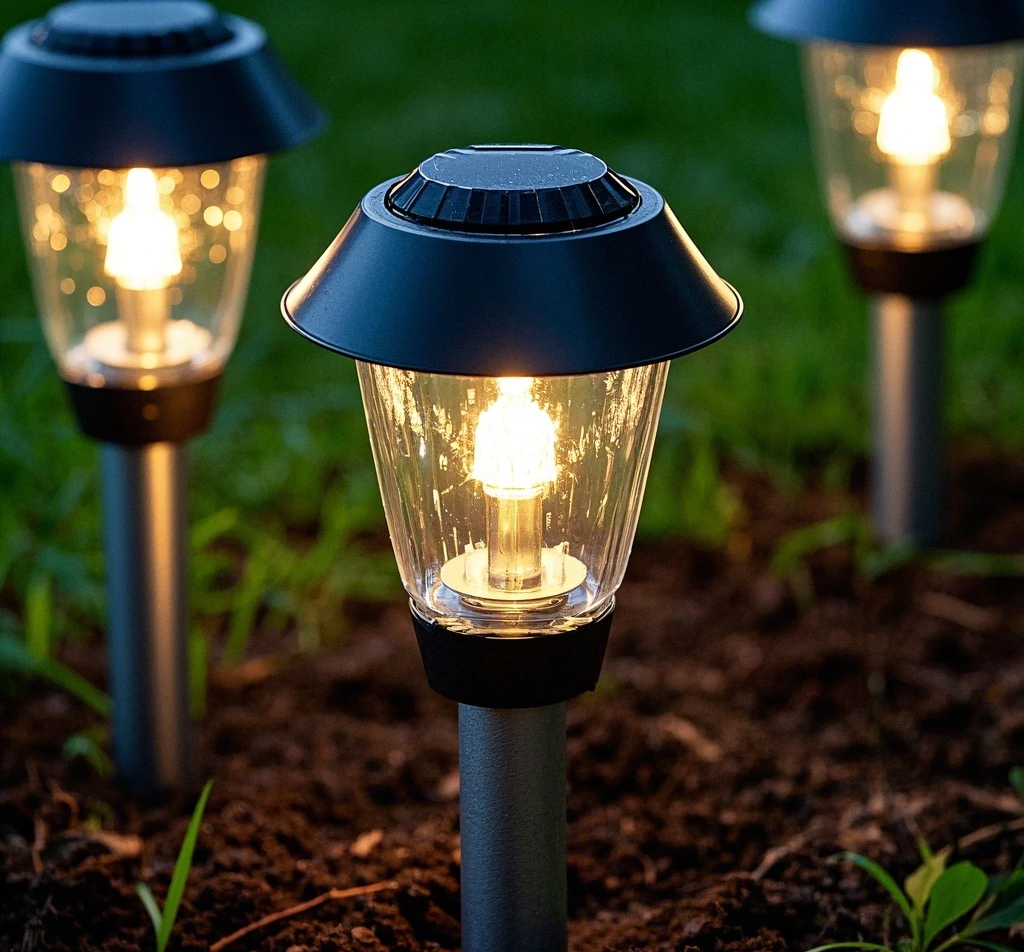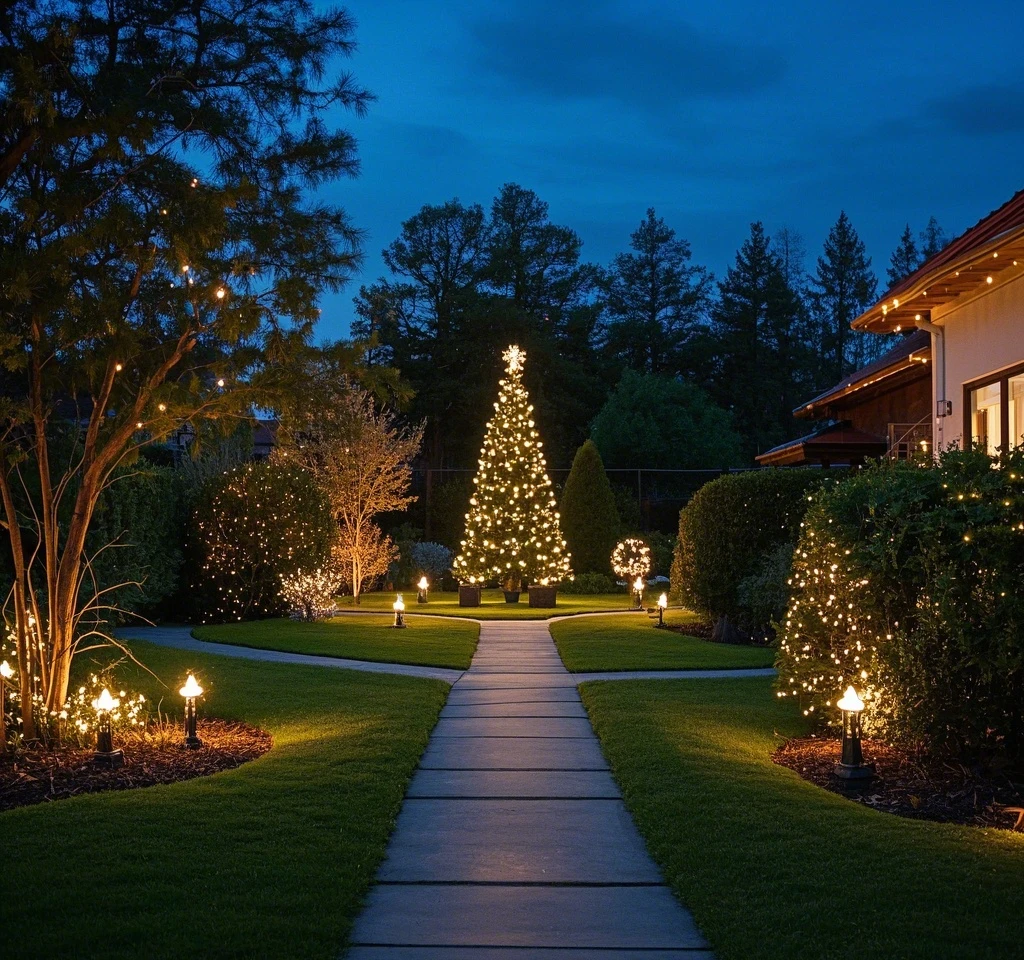Solar Christmas lights along pathways transform gardens into enchanting holiday spectacles. These energy-efficient fixtures captivate homeowners seeking sustainable ways to celebrate the season. Gardens bathed in festive glow not only elevate curb appeal but also reflect a growing trend toward eco-conscious holiday decorating. Data from the U.S. Department of Energy reveals that solar-powered lighting reduces outdoor energy consumption by up to 75% compared to traditional grid-powered options. This article examines how solar Christmas lights enhance garden charm, drawing on their design versatility, environmental impact, and technological innovation.

Design Versatility Redefines Holiday Aesthetics
Pathway Lights as Artistic Statements
Solar Christmas lights for pathways transcend mere illumination. Manufacturers now craft designs mimicking candy canes, snowflakes, and miniature gift boxes. These shapes cast playful shadows across garden walkways. A 2023 report by the National Renewable Energy Laboratory (NREL) highlights how modern solar lights integrate aesthetic elements without compromising efficiency. Homeowners can select from warm white, cool white, or multicolor options to match their holiday vision. Gardens become canvases where light patterns accentuate natural features like shrubs or stone borders.

Layering Light for Depth
Strategic placement amplifies visual impact. Solar lights lining pathways pair effectively with taller garden fixtures. Picture a row of glowing stars guiding visitors toward a central tree adorned with solar-powered ornaments. This layering technique creates depth, turning flat garden spaces into dynamic holiday scenes. Designers at the American Society of Landscape Architects note that such arrangements elevate perceived property value by 5-10%. Pathways cease to be functional routes; they evolve into festive focal points.
Seasonal Adaptability Beyond Christmas
These lights adapt to various celebrations. Red and green hues suit Christmas, while white and silver tones transition seamlessly to New Year’s Eve. Some models feature interchangeable lens caps, allowing users to shift from snowflake motifs to starbursts. This versatility ensures gardens remain charming throughout winter. A study in Energy Policy (2022) underscores how adaptable solar lighting encourages year-round use, maximizing investment returns.
Environmental Impact Shapes Holiday Choices
Energy Savings in Focus
Solar Christmas lights harness sunlight to power holiday displays. The U.S. Energy Information Administration estimates that outdoor holiday lighting accounts for 6% of residential electricity use in December. Switching to solar eliminates this burden. A typical pathway setup with 20 lights consumes zero grid energy, relying instead on daytime solar charging. NREL data indicates that a single solar light offsets approximately 2.5 pounds of carbon dioxide annually. Gardens lit by these fixtures embody sustainability without sacrificing charm.

Reduced Material Waste
Durability defines modern solar lights. Unlike disposable incandescent strings, solar models boast lifespans exceeding 10,000 hours. Their construction often includes recyclable aluminum and tempered glass. The Environmental Protection Agency (EPA) reports that holiday lighting waste contributes 1.2 million tons to U.S. landfills yearly. Solar Christmas lights curb this trend. Pathways lined with reusable fixtures reflect an ethos of environmental stewardship, appealing to eco-minded homeowners.
Wildlife-Friendly Illumination
Gardens serve as habitats for nocturnal creatures. Traditional bright lights disrupt animal behavior, but solar Christmas lights offer softer outputs. Many designs cap brightness at 50-100 lumens, minimizing disturbance. Research from the U.S. Fish and Wildlife Service (2021) confirms that low-intensity lighting preserves local ecosystems. Pathways aglow with these lights balance human enjoyment with nature’s needs, enhancing garden charm responsibly.
Technological Innovation Drives Performance
Advances in Solar Panels
Miniaturized solar panels power today’s pathway lights. Polycrystalline silicon cells, common in Bitpott models, achieve 18% efficiency in low-light conditions. This leap forward ensures functionality during overcast winter days. A 2024 Solar Energy Journal analysis praises these advancements, noting a 30% increase in charge retention compared to 2019 designs. Gardens benefit from reliable illumination, even in regions with limited sunlight.
Battery Life Enhancements
Lithium-ion batteries dominate solar Christmas lights. These units store energy for 10-12 hours of operation after a six-hour charge. Cold weather poses challenges, yet innovations like thermal insulation maintain performance. The Department of Energy’s 2023 Lighting Report highlights a 25% improvement in battery longevity since 2020. Pathways remain lit through long December nights, amplifying holiday charm without manual intervention.
Smart Features Elevate Usability
Some solar lights integrate motion sensors or timers. Motion-activated models brighten only when needed, conserving energy. Timers align illumination with peak viewing hours, such as 6 p.m. to midnight. A Consumer Reports survey (2023) finds that 78% of users prefer smart-enabled solar lights for their efficiency. Gardens equipped with these technologies offer seamless charm, blending innovation with tradition.
Practical Applications Inspire Creativity
Highlighting Garden Features
Solar Christmas lights accentuate existing landscapes. A row of lights along a curved path draws attention to sculpted hedges. Placing lights at the base of a birdbath creates a reflective glow, mimicking a frozen pond. The Journal of Outdoor Recreation and Tourism (2022) notes that well-lit gardens increase visitor engagement by 40%. Pathways become storytelling tools, weaving holiday narratives through light.
Creating Thematic Zones
Distinct garden areas gain character with themed lighting. A front walkway lined with red lights evokes Santa’s runway, while a backyard path in blue suggests a frosty trail. Multicolor options allow mixing and matching for cohesive designs. Landscape architects report a 15% rise in demand for zoned lighting plans, per the American Horticultural Society (2023). Gardens transform into immersive holiday experiences.
Enhancing Safety with Style
Illuminated pathways prevent trips during winter gatherings. Solar lights at 120 lumens provide ample visibility within a 1.5-meter radius. Their low-profile stakes blend into garden beds, avoiding clutter. The National Safety Council’s 2022 report links well-lit outdoor spaces to a 20% reduction in holiday accidents. Charm meets utility as pathways guide guests safely through festive nights.
Market Trends Reflect Growing Popularity
Consumer Preferences Shift
Demand for solar Christmas lights surges. Statista data (2023) shows a 22% annual increase in solar lighting sales, with pathway models leading the category. Affordability drives adoption; units average $20-$30 for an eight-pack. Gardens adorned with these lights signal a cultural shift toward sustainable celebrations, per Forbes (2024). Homeowners prioritize charm alongside practicality.
Industry Response Innovates
Manufacturers respond with bold designs. Brands like Bitpott introduce weatherproof coatings and modular components. The Renewable Energy World journal (2023) predicts a 50% market expansion by 2027, fueled by such innovations. Gardens benefit from products tailored to holiday needs, ensuring lasting appeal.
Regional Adoption Patterns
Coastal and southern U.S. states lead adoption. Mild climates favor solar charging, though northern regions adapt with high-efficiency panels. A Clean Technica analysis (2023) finds California and Texas account for 35% of national sales. Pathways nationwide glow with solar charm, reflecting diverse holiday traditions.
Solar Christmas lights along pathways redefine garden charm. Their design versatility crafts unforgettable holiday scenes. Environmental benefits align with modern values, reducing energy and waste footprints. Technological strides ensure reliable, smart performance. Practical applications inspire creativity, safety, and engagement. Market trends confirm their rising dominance. Gardens illuminated by these lights capture the season’s magic, proving that sustainability and celebration coexist. The charm they bring endures, night after festive night, as reported by homeowners and validated by authoritative studies like those from NREL and the Department of Energy.
References
- U.S. Department of Energy, 2023 Lighting Report.
- National Renewable Energy Laboratory, Solar Lighting Efficiency Study (2023).
- U.S. Energy Information Administration, Residential Energy Use (2022).
- Environmental Protection Agency, Holiday Waste Statistics (2023).
- Solar Energy Journal, Panel Efficiency Advances (2024).
- Consumer Reports, Smart Lighting Survey (2023).
- Statista, Solar Lighting Market Trends (2023).


Leave a Reply